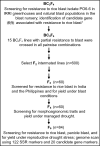Accumulating candidate genes for broad-spectrum resistance to rice blast in a drought-tolerant rice cultivar
- PMID: 34728643
- PMCID: PMC8563964
- DOI: 10.1038/s41598-021-00759-9
Accumulating candidate genes for broad-spectrum resistance to rice blast in a drought-tolerant rice cultivar
Abstract
Biotic stresses, including diseases, severely affect rice production, compromising producers' ability to meet increasing global consumption. Understanding quantitative responses for resistance to diverse pathogens can guide development of reliable molecular markers, which, combined with advanced backcross populations, can accelerate the production of more resistant varieties. A candidate gene (CG) approach was used to accumulate different disease QTL from Moroberekan, a blast-resistant rice variety, into Vandana, a drought-tolerant variety. The advanced backcross progeny were evaluated for resistance to blast and tolerance to drought at five sites in India and the Philippines. Gene-based markers were designed to determine introgression of Moroberekan alleles for 11 CGs into the progeny. Six CGs, coding for chitinase, HSP90, oxalate oxidase, germin-like proteins, peroxidase and thaumatin-like protein, and 21 SSR markers were significantly associated with resistance to blast across screening sites. Multiple lines with different combinations, classes and numbers of CGs were associated with significant levels of race non-specific resistance to rice blast and sheath blight. Overall, the level of resistance effective in multiple locations was proportional to the number of CG alleles accumulated in advanced breeding lines. These disease resistant lines maintained tolerance to drought stress at the reproductive stage under blast disease pressure.
© 2021. The Author(s).
Conflict of interest statement
The authors declare no competing interests.
Figures






References
-
- Huke RE, Huke EH. Rice, Then & Now. International Rice Research Institute; 1990.
-
- Bonman JM. Durable resistance to rice blast disease-environmental influences. Euphytica. 1992;63:115. doi: 10.1007/BF00023917. - DOI
-
- Sharma T, et al. Rice blast management through host-plant resistance: Retrospect and prospects. Agric. Res. 2012;1:37–52. doi: 10.1007/s40003-011-0003-5. - DOI
Publication types
MeSH terms
Substances
Grants and funding
LinkOut - more resources
Full Text Sources
Research Materials

